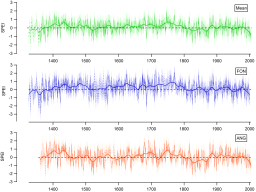French summer droughts since 1326 CE: a reconstruction based on tree ring cellulose δ18O

Fig. 1. Reconstructions of the drought index SPEI (June–August) based on tree ring cellulose d18O for Fontainebleau (FON), Angoulême (ANG), and a composite reconstruction for the two sites (mean). The thick lines are the fitted 30-year cubic smoothing splines. The shaded areas mark the confidence intervals of the reconstructions, and the dotted lines mark the parts of the chronologies where the number of trees is < 4.
This article presents a reconstruction of summer droughts in France based on annually resolved, absolutely dated chronologies of oxygen isotope ratios (δ18O) in tree ring cellulose from Quercus spp. Samples were taken from living trees and timber wood from historic buildings at two sites: Fontainebleau (48°23’ N, 2°40’ E; 1326–2000 CE) and Angoulême (45°44’ N, 0°18’ E; 1360–2004 CE). Cellulose δ18O from these sites proved to be a good proxy of summer climate, as the trees were sensitive to temperature and moisture availability. However, offsets in average δ18O values between tree cohorts necessitated a correction before joining them to the final chronologies. Using the corrected δ18O chronologies, we developed models based on linear regression to reconstruct drought, expressed by the standardized precipitation evapotranspiration index (SPEI). The significant correlations between the SPEI and cellulose δ18O (r=0.70), as well as the verification of the models by independent data support the validity of these reconstructions. At both sites, recent decades are characterized by increasing drought. Fontainebleau displays dominantly wetter conditions during earlier centuries, whereas the current drought intensity is not unprecedented in the Angoulême record. While the δ18O chronologies at the two studied sites are highly correlated during the 19th and 20th centuries, there is a significant decrease in the correlation coefficient between 1600 and 1800 CE, which indicates either a weaker climate sensitivity of the tree ring proxies during this period, or a more heterogeneous climate in the north and the south of France. Future studies of tree ring isotope networks might reveal if the seasonality and spatial patterns of past droughts can explain this decoupling.
Authors : I. Labuhn, V. Daux, O. Girardclos, M. Stievenard, M. Pierre, V. Masson-Delmotte
Ref. : Climate of the Past, 12, 1101–1117.






